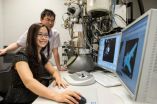(Press-News.org) The first direct observations of how facets form and develop on platinum nanocubes point the way towards more sophisticated and effective nanocrystal design and reveal that a nearly 150 year-old scientific law describing crystal growth breaks down at the nanoscale.
Researchers with the U.S. Department of Energy (DOE)'s Lawrence Berkeley National Laboratory (Berkeley Lab) used highly sophisticated transmission electron microscopes and an advanced high-resolution, fast-detection camera to capture the physical mechanisms that control the evolution of facets – flat faces – on the surfaces of platinum nanocubes formed in liquids. Understanding how facets develop on a nanocrystal is critical to controlling the crystal's geometric shape, which in turn is critical to controlling the crystal's chemical and electronic properties.
"For years, predictions of the equilibrium shape of a nanocrystal have been based on the surface energy minimization proposal by Josiah Willard Gibbs in the 1870s to describe the equilibrium shape of a water droplet," says Haimei Zheng, a staff scientist in Berkeley Lab's Materials Sciences Division who led this study. "For nanocrystals, the idea is that during crystal growth, high-energy facets will grow at a higher rate than low-energy facets and eventually disappear, resulting in a nanocrystal whose shape is configured to minimize surface energy."
The research of Zheng and her collaborators showed that at the molecular level, the geometric shape of nanocrystals during synthesis in solution is actually driven by differences in the mobility of ligands across the surfaces of different facets.
"By choosing ligands that selectively bind on the facets, we should be able to control the shape of the nanocrystal as it grows," she says. "This would provide a new way to design nanomaterials for advanced applications, including nanostructures for bio-imaging, catalysts for solar conversion, and energy storage."
Zheng is the corresponding author of a paper in Science titled "Facet Development During Platinum Nanocube Growth." Hong-Gang Liao is the lead author. Co-authors are Danylo Zherebetskyy, Huolin Xin, Cory Czarnik, Peter Ercius, Hans Elmlund, Ming Pan and Lin-Wang Wang.
The performance of nanocrystals in such surface-enhanced applications as catalysis, sensing and photo-optics is strongly influenced by shape. While significant advances have been made in the synthesis of nanocrystals featuring a variety of shapes - cube, octahedron, tetrahedron, decahedron, icosahedron, etc., - controlling these shapes is often difficult and unpredictable.
"A major roadblock has been that the atomic pathways of facet development in nanocrystals are mostly unknown due to the lack of direct observation," Zheng says. "It has been assumed that commonly used surfactants modify the energy of specific facets through preferential adsorption, thereby influencing the relative growth rate of different facets and the shape of the final nanocrystal. However, this assumption was based on post-reaction characterizations that did not account for how facet dynamics evolve during crystal growth."
As a crystal undergoes growth, its constituent atoms or molecules fan out along specific directional planes whose coordinates are denoted by a three-digit system called the Miller Index. Facets form when the surfaces along different planes grow at different rates. Three of the most critical facets for determining a crystal's geometric shape are the so-called "low index facets," which are designated under the Miller Index as {100}, {110} and {111}.
Working with platinum, one of the most effective industrial catalysts in use today, Zheng and her collaborators initiated the growth of nanocubes in a thin layer of liquid sandwiched between two silicon nitride membranes. This microfabricated liquid cell can encapsulate and maintain the liquid inside the high vacuum of a transmission electron microscope (TEM) for an extended period of time, enabling in situ observations of single nanoparticle growth trajectories.
"With the liquid cells, we're able to use TEMs to observe the growth of nanocrystals that remarkably resemble nanocrystals synthesized in flasks," Zheng says. "We found that the growth rates of all low index facets are similar until the {100} facets stop growing. The {110} facets will continue to grow until they reach two neighboring {100} facets, at which point they form the edge of a cube whose corners will be filled in by the continued growth of {111} facets. The arrested growth of the {100} facets that triggers this process is determined by ligand mobility on the {100} facets, which is much lower than on the {110} and {111} facets."
For their observations, Zeng and her collaborators were able to use several of the TEMs at Berkeley Lab's National Center for Electron Microscopy (NCEM), a DOE Office of Science user facility, including the TEAM 0.5 instrument, the world's most powerful TEM. In addition, they were able to use a K2-IS camera from Gatan, Inc., which can capture electron images directly onto a CMOS sensor at 400 frames per second (fps) with 2K-by-2K pixel resolution.
"The K2-IS camera can also be configured to capture images at up to 1600 fps with appropriate scaling of the field of view, which is critical for observing particles that are moving dynamically in the field of view," says lead author Liao, a member of Zheng's research group. "The elimination of the traditional scintillation process during image detection results in significant improvement in both sensitivity and resolution. High resolution imaging is also facilitated by the thin silicon nitride membranes of our liquid cell window, which is about 10 nanometers thick per membrane."
The lower ligand mobility and arrested growth of selected facets experimentally observed by Zheng and Liao, were supported by ab initio calculations carried out under the leadership of co-author Wang, a senior scientist with the Materials Sciences Division who heads the Computational Material Science and Nano Science group.
"At first, we thought the continued growth in the {111} direction might be a result of higher surface energy on the {111} plane," says co-author Zherebetskyy, a member of Wang's group. "The experimental observations forced us to consider alternative mechanisms and our calculations show that the relatively low energy barrier on the {111} plane allow the ligand molecules on that plane to be very mobile."
Says Wang, "Our collaboration with Haimei Zheng's group showcases how ab initio calculations can be combined with experimental observations to shed new light on hidden molecular processes."
Zheng and her group are now in the process of determining whether the ligand mobility in platinum that shaped the formation of cube-shaped nanocrystals also applies to ligands in other nanomaterials and the formation of nanocrystals in other geometric shapes.
This research was supported by the DOE Office of Science.
INFORMATION:
Lawrence Berkeley National Laboratory addresses the world's most urgent scientific challenges by advancing sustainable energy, protecting human health, creating new materials, and revealing the origin and fate of the universe. Founded in 1931, Berkeley Lab's scientific expertise has been recognized with 13 Nobel prizes. The University of California manages Berkeley Lab for the U.S. Department of Energy's Office of Science. For more, visit http://www.lbl.gov.
The DOE Office of Science is the single largest supporter of basic research in the physical sciences in the United States and is working to address some of the most pressing challenges of our time. For more information, please visit science.energy.gov.
Shaping the future of nanocrystals
Berkeley Lab researchers obtain first direct observation of facet formation in nanocubes
2014-08-21
ELSE PRESS RELEASES FROM THIS DATE:
Fungus deadly to AIDS patients found to grow on trees
2014-08-21
DURHAM, NC -- Researchers have pinpointed the environmental source of fungal infections that have been sickening HIV/AIDS patients in Southern California for decades. It literally grows on trees.
The discovery is based on the science project of a 13-year-old girl, who spent the summer gathering soil and tree samples from areas around Los Angeles hardest hit by infections of the fungus named Cryptococcus gattii (CRIP-to-cock-us GAT-ee-eye).
Cryptococcus, which encompasses a number of species including C. gattii, causes life-threatening infections of the lungs and brain ...
Low birth weight linked to higher incidence of type 2 diabetes in African American women
2014-08-21
(Boston) — African American women born at a low or very low birth weight may be at a higher risk for developing type 2 diabetes. The findings, which appear in Diabetes Care, may explain in part the higher occurrence of type 2 diabetes in African American populations, which has a high prevalence of low birth weight.
Researchers from Boston University's Slone Epidemiology Center followed more than 21,000 women enrolled in the Black Women's Health Study over the course of 16 years, analyzing characteristics such as birth weight, current age, family history of diabetes, body ...
Enabling a new future for cloud computing
2014-08-21
The National Science Foundation (NSF) today announced two $10 million projects to create cloud computing testbeds--to be called "Chameleon" and "CloudLab"--that will enable the academic research community to develop and experiment with novel cloud architectures and pursue new, architecturally-enabled applications of cloud computing.
Cloud computing refers to the practice of using a network of remote servers to store, manage and process data, rather than a local server or a personal computer. In recent years, cloud computing has become the dominant method of providing ...
NASA scientists watching, studying Arctic changes this summer
2014-08-21
VIDEO:
In this animation, the Earth rotates slowly as the Arctic sea ice advances over time from March 21, 2014 to August 3, 2014.
Click here for more information.
As we near the final month of summer in the Northern Hemisphere, NASA scientists are watching the annual seasonal melting of the Arctic sea ice cover. The floating, frozen cap that stretches across the Arctic Ocean shrinks throughout summer until beginning to regrow, typically around mid-September.
As of Aug. 19, ...
Extracorporeal support can significantly increase number of organs for transplant
2014-08-21
Ann Arbor, Mich. — Using heart-lung support technology, the University of Michigan's Transplant Center was able to increase the number of kidneys, livers and pancreases available for transplant by about 20 percent.
The results were published in the journal Transplantation and detail the impact of more than 10 years of using Extracorporeal Membrane Oxygenation, or ECMO, to improve the quality and viability of organs donated after circulatory determination of death.
"Organ transplant is limited by the number of donated organs available, so the use of organs that are donated ...
Liberal democracy is possible in Muslim-majority countries
2014-08-21
A new study by University of Toronto and University of Tübingen researchers suggests that Islam is not as much of an impediment to liberal democracy as is often thought.
"One of the key markers for a successful liberal democracy is a high degree of social tolerance," says U of T sociologist Robert Andersen. "We wanted to see the extent to which this existed in countries with a majority of Muslims compared to Western countries."
Andersen, U of T sociologist Robert Brym and Scott Milligan of the University of Tübingen used data from the World Values Survey – a global ...
Canola genome sequence reveals evolutionary 'love triangle'
2014-08-21
Athens, Ga. – An international team of scientists including researchers from the University of Georgia recently published the genome of Brassica napus—commonly known as canola—in the journal Science. Their discovery paves the way for improved versions of the plant, which is used widely in farming and industry.
Canola is grown across much of Canada and its native Europe, but the winter crop is increasingly cultivated in Georgia. Canola oil used for cooking is prized for its naturally low levels of saturated fat and rich supply of omega-3 fatty acids, but the plant is ...
Despite a significant reduction in smog-producing toxins, the Greater Toronto Area still violates Canada's standards for ozone air pollution
2014-08-21
Despite a significant reduction in smog-producing toxins in past decade, GTA still violates Canada's ozone standards
A new study shows that while the Greater Toronto Area (GTA) has significantly reduced some of the toxins that contribute to smog, the city continues to violate the Canada-wide standards for ozone air pollution.
Smog, which can cause or aggravate health problems such as asthma, emphysema and chronic bronchitis, is produced by a set of complex photochemical reactions involving volatile organic compounds (VOCs), nitrogen oxides and sunlight, which form ground-level ...
Orgasm rates for single women less predictable than men's, vary by sexual orientation
2014-08-21
BLOOMINGTON, Ind. -- A new study of American singles found that during sex with a familiar partner, men have the highest orgasm rates. On average, men experience orgasm 85.1 percent of the time, with their sexual orientation making little difference. For women, however, orgasm occurrence is less predictable. On average, women experience orgasm 62.9 percent of the time during sex with a familiar partner -- and this pattern varies with women's sexual orientation, with lesbian women experiencing orgasm more often than heterosexual or bisexual women.
The Indiana University ...
Losing weight lowers health care costs for adults with type 2 diabetes
2014-08-21
WINSTON-SALEM, N.C. – Aug. 21, 2014 – Overweight individuals with diabetes who lose weight by dieting and increasing their physical activity can reduce their health care costs by an average of more than $500 per year, according to a new study.
"Lifestyle interventions promoting weight loss and physical activity are recommended for overweight and obese people with Type 2 diabetes to improve their health," said Mark A. Espeland, professor of public health sciences at Wake Forest Baptist Medical Center and lead author of the study. "This is the first study to show that weight ...
LAST 30 PRESS RELEASES:
Mental trauma succeeds 1 in 7 dog related injuries, claims data suggest
Breastfeeding may lower mums’ later life depression/anxiety risks for up to 10 years after pregnancy
Study finds more than a quarter of adults worldwide could benefit from GLP-1 medications for weight loss
Hobbies don’t just improve personal lives, they can boost workplace creativity too
Study shows federal safety metric inappropriately penalizes hospitals for lifesaving stroke procedures
Improving sleep isn’t enough: researchers highlight daytime function as key to assessing insomnia treatments
Rice Brain Institute awards first seed grants to jump-start collaborative brain health research
Personalizing cancer treatments significantly improve outcome success
UW researchers analyzed which anthologized writers and books get checked out the most from Seattle Public Library
Study finds food waste compost less effective than potting mix alone
UCLA receives $7.3 million for wide-ranging cannabis research
Why this little-known birth control option deserves more attention
Johns Hopkins-led team creates first map of nerve circuitry in bone, identifies key signals for bone repair
UC Irvine astronomers spot largest known stream of super-heated gas in the universe
Research shows how immune system reacts to pig kidney transplants in living patients
Dark stars could help solve three pressing puzzles of the high-redshift universe
Manganese gets its moment as a potential fuel cell catalyst
“Gifted word learner” dogs can pick up new words by overhearing their owners’ talk
More data, more sharing can help avoid misinterpreting “smoking gun” signals in topological physics
An illegal fentanyl supply shock may have contributed to a dramatic decline in deaths
Some dogs can learn new words by eavesdropping on their owners
Scientists trace facial gestures back to their source. before a smile appears, the brain has already decided
Is “Smoking Gun” evidence enough to prove scientific discovery?
Scientists find microbes enhance the benefits of trees by removing greenhouse gases
KAIST-Yonsei team identifies origin cells for malignant brain tumor common in young adults
Team discovers unexpected oscillation states in magnetic vortices
How the brain creates facial expressions
Researchers observe gas outflow driven by a jet from an active galactic nucleus
Pitt student finds familiar structure just 2 billion years after the Big Bang
Evidence of cross-regional marine plastic pollution in green sea turtles
[Press-News.org] Shaping the future of nanocrystalsBerkeley Lab researchers obtain first direct observation of facet formation in nanocubes





